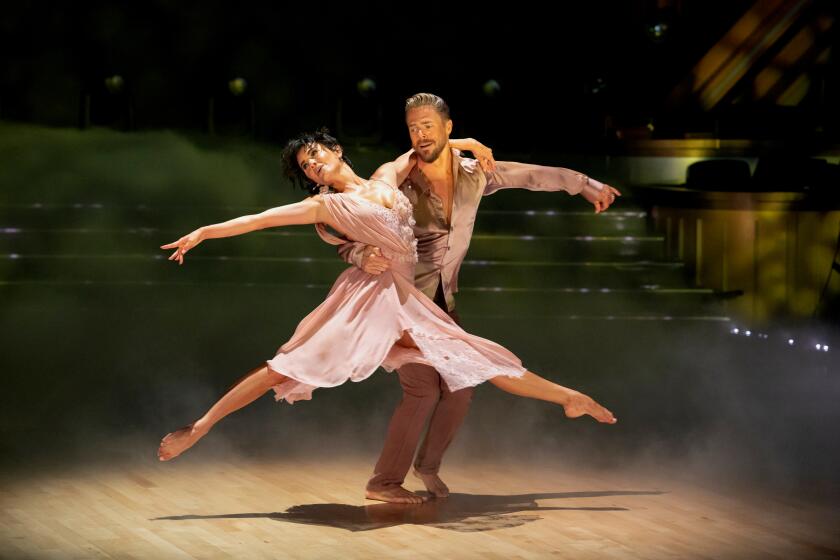Ligeti puts Beethoven in perspective
One of the most exalted versions of Beethoven’s Ninth Symphony I know of is a film documenting a Berlin Philharmonic performance conducted by Wilhelm Furtwangler. But to hear the glorious Finale, with its lofty call to universal brotherhood, performed with spiritual fervor and then to watch the camera pan to an audience of intensely moved Nazi leaders is enough to generate a moral crisis in a listener.
But in the 182 years since its premiere in Vienna, the Ninth has thrilled and inspired, through live performances and recordings, probably a billion people by now, making Hitler and his cronies at least statistically insignificant. Thursday night, Esa-Pekka Salonen and the Los Angeles Philharmonic added a couple of thousand more thrill seekers to the count in a packed Walt Disney Concert Hall.
What’s more, for this exceptional program in the orchestra’s Beethoven Unbound series, the thrills were moral as well as musical. The first piece on the program was Ligeti’s Requiem, and it put Beethoven’s masterpiece in an extraordinarily interesting light.
Beethoven and Ligeti are among music’s big-time sufferers and moralists. Deaf and loveless at the end of life, Beethoven reached out to humanity at large, if in the abstract. Ligeti’s grotesque perspective on life and his chronic poor health are consequences of his experiences in World War II. Born in 1923 in a section of Transylvania that now belongs to Romania, he was forced by the Nazis into a Jewish labor battalion that he nonetheless survived. Most of his family perished in concentration camps.
The Requiem reveals a composer on a first-name basis with a wrathful God. It is a piece that, in the conventional sense, offers no hope. Written for orchestra, large chorus and two vocal soloists, it encompasses only the first half of the traditional Requiem text, the gloomy scary parts about the horror of Judgment Day.
It was finished in 1965, and each of its four sections is a complex working out of advanced avant-garde techniques of the time. The chorus, divided into dozens of individual lines, creates clouds of sounds that might be the auditory equivalent of radioactive fallout. The soloists leap about musically in violent expression. The orchestral writing reveals mysterious, intricate textures that seem to darken everything they touch.
And yet the Requiem goes beyond depressing into a kind of hyperrealism. Ligeti’s defense against the terrors of death is mockery. At one point, he had thought he might make this a Requiem with a cuckoo clock accompaniment of glockenspiels and bells. Instead, he came up with something far grimmer but also gripping in the dramatic power and originality of its sound world.
Salonen’s performance was not dramatically over the top, as some conductors like to make this Requiem. The drama is easy. The notes aren’t. Salonen went for detail and accuracy, allowing Ligeti’s fascinating textures their own authority. No other music sounds like this, and to hear the incredible timbres in the clarity of Disney’s acoustic, given the proper attention and balance by the Philharmonic, the mighty Master Chorale and two able soloists (Caroline Stein and Jill Grove) was, I suspect, a unique experience in the performance history of this work.
That history goes back to the premiere in Stockholm, when Beethoven’s Ninth was also on the program. Back then, one British critic found Ligeti’s score so shattering that he wrote he would gladly have forgone the Beethoven. I wouldn’t have Thursday.
A Furtwangler Ninth here would have been intolerable. But Salonen’s tight, focused, thrusting, thrilling performance was nothing at all like that. With Ligeti having sensitized the audience’s ears, Salonen underlined Beethovenian detail while simultaneously producing a vigorous sense of direction.
I didn’t sense that he was dreaming of starry nights in the cosmic opening measures or giving us a big sloppy kiss in the brotherhood bear hug of the ending. This was not a time for cheap sentiment. Ligeti’s Requiem reminds us of what is coming and that we’d better smell the flowers while we can. Salonen was Beethoven’s gardener, watering the flowers.
I noticed details in Thursday’s performance I never had in this familiar music. And I discovered colors I didn’t know existed, thanks to the Philharmonic’s high-definition performance.
The Master Chorale sang with ecstasy on their breaths. Twyla Robinson, Grove, Marcus Haddock and Alan Held were the soloists. Their tendency was to be operatic, but Salonen drove them hard to minimize any harm.
*
Los Angeles Philharmonic
Where: Walt Disney Concert Hall, 111 S. Grand Ave., L.A.
When: 8 tonight
Price: $15 to $129
Contact: (323) 850-2000 or www.laphil.com
More to Read
The biggest entertainment stories
Get our big stories about Hollywood, film, television, music, arts, culture and more right in your inbox as soon as they publish.
You may occasionally receive promotional content from the Los Angeles Times.











